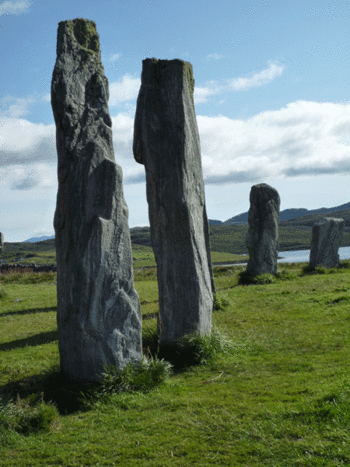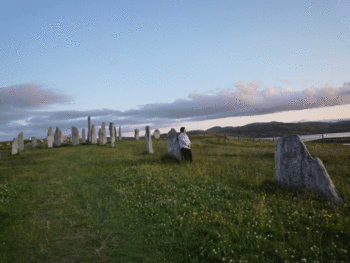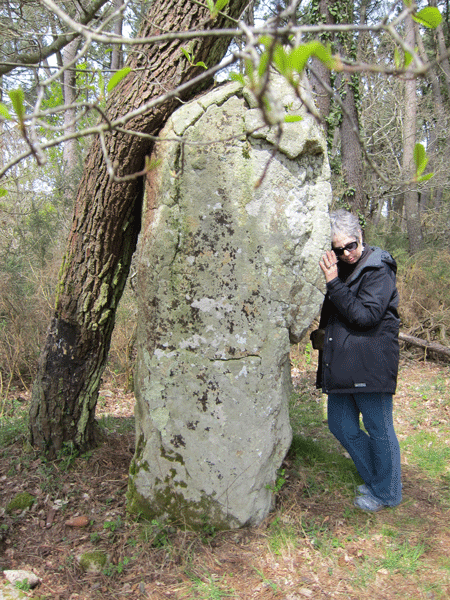words + photos by Elyn Aviva
It was a light and stormy night in late June, 2006, the second light and stormy night since we had arrived at the edge of nowhere. We had traveled for days to reach the Isle of Lewis, most northern isle of the Scottish Western Isles, to witness a rare astronomical event called the Lunar Standstill. Raw and rough, the wind felt as if it had blown in from around the world—and it had, for there was nothing in the Atlantic to slow it down.
 We had journeyed by bus and ferry and car to stand before the Standing Stones of Calanais (aka Callanish), to participate in the once-every-18.61 years Lunar Standstill. The pale sun would set around 11 pm, and then the full moon would skim the southern horizon, go behind Sleeping Beauty Hill, and come out again—giving the appearance of a double rising—and shine between two tall stones in the central stone ring. Archeo-astronomers believe this marking of the movements of the moon gave the builders important power 5000 years ago.
We had journeyed by bus and ferry and car to stand before the Standing Stones of Calanais (aka Callanish), to participate in the once-every-18.61 years Lunar Standstill. The pale sun would set around 11 pm, and then the full moon would skim the southern horizon, go behind Sleeping Beauty Hill, and come out again—giving the appearance of a double rising—and shine between two tall stones in the central stone ring. Archeo-astronomers believe this marking of the movements of the moon gave the builders important power 5000 years ago.
Calanais consists of a slightly squashed central ring, four radiating stone arms, and an underground, box-shaped cairn. The central megaliths stand 8-12 feet high, their uneven silhouettes resembling a Rorscharch test. Was it a temple? A cemetery? A community center? A calendar? Nobody knows for sure. The silent stones reveal their purpose slowly, if at all.
We couldn’t wait to see the Lunar Standstill, but wait we had to. The night before, icy rain had ruined our chances. We hoped for better the second night, but the moon had coyly disappeared behind a layer of clouds, only occasionally peeking out. The event was taking place right before our eyes, but we couldn’t see it.
We had been drawn to this desolate distant land because we wanted to experience what the ancients had experienced (whatever that might have been) millennia ago. We were not alone in that desire. Shivering dreadlocked tie-dyed youth chanted and drummed to the moon, equally determined to have an experience. Nor were we and they the only watchers on that wild and windy night. A choir of Church of Scotland youth clung together, courageously singing “Amazing Grace” against the encroaching pagan forces. As if intimidated by such competing claims, the moon scuddled behind another back-lit cloud and stayed there.
At the end of the stone-lined path that led north from the ring of monoliths, a group of blanket-wrapped elders sat on chairs, impatient with those who blocked their view back down the aisle. Oblivious to their muttered complaints, a photographer set up his tripod in front of them. He pointed his camera toward Sleeping Beauty, waiting for a momentary glimpse of the moon gleaming between two grey and glistening stones. They looked like giant fingers pointing at the sky.
 Why stand there, I asked? Was there a stone that marked the spot, the proper place to view this rare occurrence? He shook his head and lectured me on parallax: he would shoot the moon between the monoliths as soon as it appeared from behind the hill and clouds. Why wait for the exact moment (sometime after midnight, when the moon would be most full) when expediency would do?
Why stand there, I asked? Was there a stone that marked the spot, the proper place to view this rare occurrence? He shook his head and lectured me on parallax: he would shoot the moon between the monoliths as soon as it appeared from behind the hill and clouds. Why wait for the exact moment (sometime after midnight, when the moon would be most full) when expediency would do?
The sky maintained its eerie glow ‘til almost midnight; the sun barely sets this far north. We waited. What could we do but wait? In the scale of millennia, a few minutes, an hour, a day meant nothing.
And then it happened. The moon peeked out from behind the clouds, disappeared behind the hill, then rose again on the other side, shining bright and gold between two standing sentinel stones. A cheer broke through the crowd. A hush soon followed. The moon shown for a moment, then retreated behind a bank of clouds. Rain pummeled down. Soaked and trembling with cold, we stumbled to the car for shelter.
Was that all there was, I thought? A momentary glimpse of the full moon between two upward-thrusting stones—off-center at that, as if marking the event were some kind of afterthought? I had come so far, eager to experience in my bones (chilled though they were) what might have been, what could have been—to share in an event that linked my “now” with an ancient “then.” But having seen it, I was not convinced. No “X” marked the spot from which to view this rare event. No heel stone stood in line for careful sighting of the rising, setting moon to indicate “Now is the night” and not some other. Like the photographer, I could have stood anywhere close by and seen the moon shine through the gap between the stones. Perhaps I expected too much, a precision foreign to those ancestral minds, those master builders who erected the massive stones. Or perhaps it never was intended.
It didn’t matter, I realized, as I stared out at the megaliths, fierce and commanding in the storm. I had come for one thing but had discovered something more important. I had learned I couldn’t experience what the ancestors had—I could only experience what happened here and now. The Calanais Stones had stood for 5000 years while the world turned and the stars shifted in the sky, while civilizations came and went and generations lived and died. I might construct or reconstruct or misconstruct their purpose in the past, but I knew now what they meant to me: a potent reminder of the ongoing mystery of what and why and wherefore. They’d drawn me from another continent, across the sea, to stand in drenching rain and lashing wind to watch the moon rise and set beneath their tireless gaze.
Elyn Aviva is a writer, fiber artist, and transformational traveler. She is fascinated by pilgrimage and sacred sites. Her PhD in anthropology was on the modern Camino de Santiago in Spain. Aviva is co-author of Powerful Places on the Caminos de Santiago, Powerful Places in Scotland, and other books on pilgrimage and journey. Calanais is one of the special places described in Powerful Places in Scotland. To learn more, go to www.pilgrimsprocess.com and www.fiberalchemy.com
If you enjoy the articles on YourLifeIsATrip.com, please visit another great resource and one of our sponsors, the Kiwi Collection: An interactive guide to the best luxury hotels, resorts, spas and destination experiences on the planet.
 ✓ Subscribe to YourLifeisaTrip.com and be notified when new articles appear, click here. It's free, it's fun, and it keeps you on the cutting edge of what our writers are thinking.
✓ Subscribe to YourLifeisaTrip.com and be notified when new articles appear, click here. It's free, it's fun, and it keeps you on the cutting edge of what our writers are thinking.


